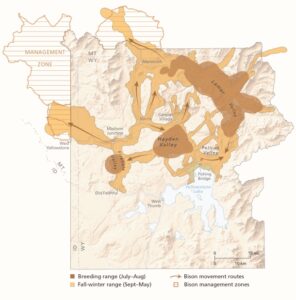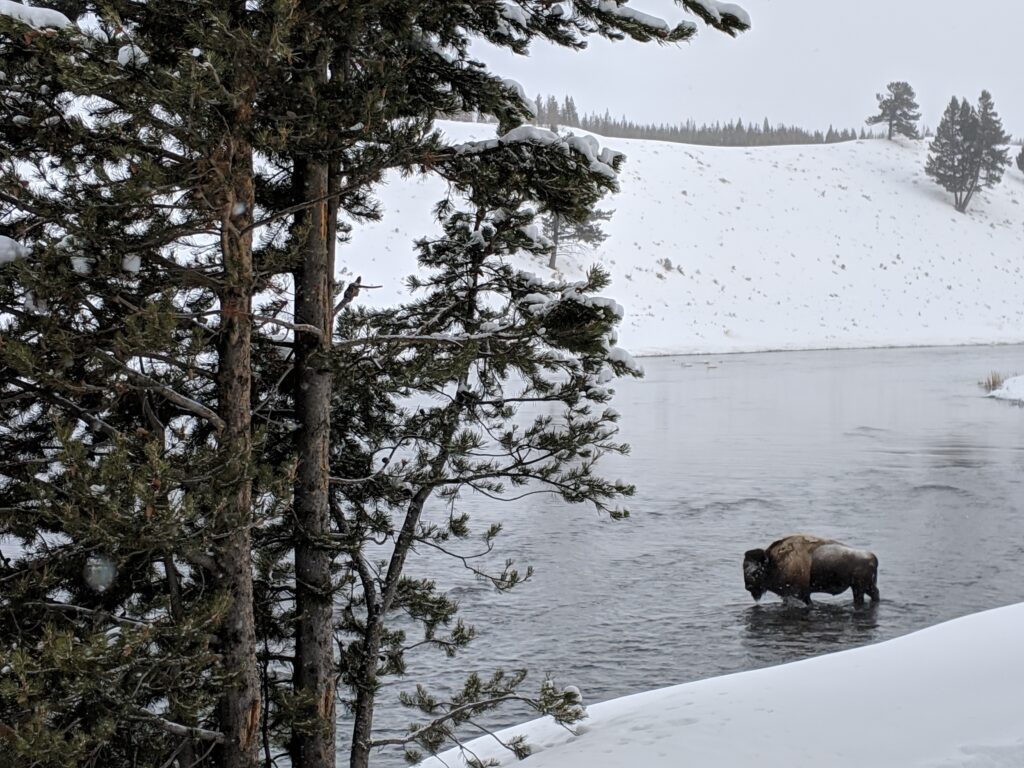Many animals have migrated out of Yellowstone for the winter, and some are hibernating, but there is one massive herbivore that continues to thrive during the harsh winter months: bison. Bison are particularly well-equipped to handle Yellowstone winters, which have an average snowfall of 150 inches per year (with higher elevations between 200-400 inches) and average daily temperatures ranging from zero to 20°F (Yellowstone Forever).
Built for Winter: Thick Coats and Snow Plowing
Bison have thick fur coats that insulate them from the cold, and their powerful legs help them move seamlessly through deep snow. This is quite the feat, considering most males weigh around 2000 lbs and females typically weigh around 1000 lbs.
Their large shoulder hump allows them to use massive neck muscles to swing their heads from side to side to clear snow away from foraging patches. This snow-plowing-like capability is unique among ungulates (hoofed animals), which normally scrape away snow with their front feet.
Herd Power
Bison are social animals that live in herds. At the height of summer, you may find herds in Yellowstone of 200+, but the average group size in winter is about 20. During the cold winter months, these herds provide warmth and protection for individual animals. Herds huddle together for shelter from the wind and snow in the winter. For these giants, there is power in numbers. When spring comes, calves are born in the relative safety of the herd. An interesting fact from the National Park Service is that bison herds appear to be directed by older females.
Migration
As winter approaches and progresses, Yellowstone bison unsurprisingly migrate to lower elevations where snow cover is less severe. This allows them to access food sources more easily. The migration also helps to prevent overgrazing in any one area.

From the National Park Service:
“Bison migrate up to 70 miles between summer and winter ranges. Most animals travel about 1,000 miles over the course of the year by repeatedly leaving and returning to the same areas. This means bison travel a greater distance than any other ungulate in the Greater Yellowstone Ecosystem.”
When visiting Yellowstone in the winter, you may see some elk and moose; hopefully, you see a coyote or a fox; and you’d be very lucky to see a wolf; but, you are almost certain to see bison! These truly remarkable creatures have adaptations and behaviors that allow them to not only survive but also thrive in the harsh winters of Yellowstone National Park. They are a testament to the power of evolution and the importance of ecological balance… and we are fortunate to witness their magic.
If you want the chance to experience these animals, book a Yellowstone Snow Coach Tour with Teton Science Schools Wildlife Expeditions. We have public and fully customizable private tours available now through March 13th, 2025.
Article Source: Bison Ecology, National Park Service


